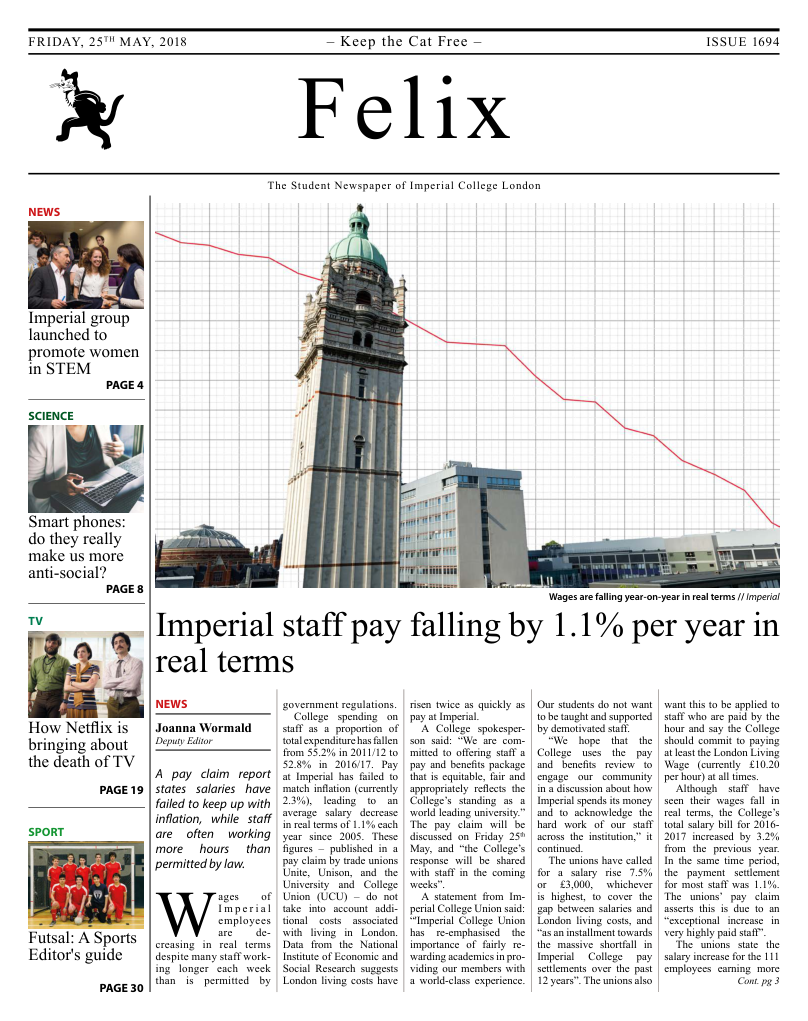ICSEDS Successfully launch high altitude balloon
The society take us through their hair-raising adventure to launch their high-altitude balloon.

The members of the IC Students for the Exploration and Development of Space Society (ICSEDS) headed out on 21st April to Elsworth, near Cambridge, to launch a balloon from an open field up to 30km into the atmosphere. On board we had our Arduino powered tracker transmitting its GPS coordinates to us on the ground packed in a livid orange box, and a 360° camera sticking out from the bottom on the end of a metre-long selfie stick. The weather was excellent for a high-altitude balloon launch, with only somewhat mild wind (anything stronger would have carried our precious balloon into the middle of the North Sea). The sky could not have been clearer, letting us capture some clear shots and keeping us warm as we prepped the payload for launch.
After filling the balloon with helium up to a pre-calculated weight, testing our tracker a few times, and double checking the camera was recording, we let go of the balloon, and it drifted off into the blue sky. We set off in a van, following the balloon across the English countryside. Soon, as the balloon rose to a few kilometres in altitude, amateur radio stations in the area started also picking up our beacon, helping map out the balloon’s trajectory as it sped off at 18m/s to the north east.
Then, in an unexpected turn, at an altitude of about 15 km, we started losing telemetry. The radio signals from our two independent trackers remained strong, but the data we received was all 0s. There seemed to be some fault with the onboard GPS equipment.
Determined not to lose track of our balloon, we drove to the point on the map above which we had earlier predicted it would reach the apex of its trajectory. Since the atmosphere thins out rapidly with altitude, the air currents above ~20 km are far too weak and the balloon went directly up above us. Using a metre-long directional radio antenna we determined the rough angle between us and the balloon, and were able to confirm that it was indeed above us. At that point we had about half an hour to wait, during which time the balloon would rise to its peak altitude, the balloon itself would burst, and the payload would fall rapidly towards the ground with a small parachute. As the payload falls below around 15 km, the air gets thick enough for the parachute to slow it down, and for atmospheric currents to start carrying it laterally. At this point, we would need to chase it once more in our van, and track where the payload touches down.
We got lucky, however, and one of our GPS trackers resumed transmitting accurate data before our payload passed back below the 15km line. As we later found out, the malfunction was likely due to the oscillator crystal getting too cold on the GPS chips, as temperature dropped sharply with altitude, causing their internal clocks to be too inaccurate to make sense of the GPS signal. As the payload fell back down into warmer atmosphere, and the oscillator warmed back up, the chip returned to its intended function with no ill effects. (You may have heard that GPS chips are designed to stop functioning above a certain altitude, but ours were designed to not have this limitation so they could be used in a high altitude flight.)
With our telemetry signal restored, first on one, then on both trackers, we could easily follow the payload’s descent as it was getting traced out automatically on a map, and followed it to its landing spot on the Great Massingham Airfield, Norfolk. We called up the airfield owner, who helped us recover our orange box. The trip back to London was spent looking over the footage from the camera, and hoping not to get stuck in Saturday evening traffic (which we did).
Overall, the balloon drifted for over two hours before bursting as we had planned, at an altitude of around 30 km. The all-important payload descended on our parachute, which proved to have been the right size for the job. Our tracking had worked during the most crucial part (descent and after landing), and arguably the most fragile part of our payload (the 360 camera with its two exposed fisheye lenses) had been protected sufficiently to survive a landing at over 4 m/s. All valuable data for our future launches, which will involve more serious scientific experiments. We would love to collaborate in future launches with those interested in sending a payload up to an altitude of 30km. With most of the atmosphere below, we can get excellent views of space, accurate atmospheric data, and, depending on the weather, a clear view of the ground below. We are always looking for new collaborators to expand the size of our projects. Do not hesitate to get in touch!









